|
|
|
| My Favourite Planet > English >
People > Ancient Greek artists> Mosaic artists |
| MFP People |
Ancient Greek artists – page 12 |
 |
Page 12 of 14 |
 |
|
| |
| Mosaic artists |
| |
Amiteion
(or Amiteios)
3rd century BC
A late third century AD mosaic, discovered in a large Roman villa at Suweydie, near Baalbek, Lebanon, signed "ΑΜΙΤΕΙΩΝ ΕΠΟΙΕΙ" (Amiteion epoiei, Amiteion created it), shows the muse Calliope surrounded by subtitled portrait medallions of the Athenian philosopher Socrates and the Seven Sages: Solon of Athens ("nothing in excess"), Thales of Miletus ("a guarantor ruins himself"), Bias of Priene ("most people are bad"), Cleobulus of Lindos ("moderation is best"), Periander of Corinth ("practice makes perfect"), Pittacus of Mytilene ("know your opportunity") and Chilon of Sparta ("know thyself").
See: Peter Green, A concise history of ancient Greece, illustration 127, page 101. Thames and Hudson, London, 1973. |
|
| |
Antaios, son of Aiskerion
Late 2nd century AD
A geometric mosaic found in the exedra of the late 2nd century AD "Sanctuary of the Syrian Gods" on Delos bears a long Greek inscription stating that it was dedicated by Midas, son of Zenon of Herakleia. At the end of the inscription is the signature ANTAIOS AISKHRIONOS EPOIEI (Antaios son of Aiskerion made [it]).
This is one of only two signatures by mosaic artists found so far on Delos. The other is by an artist named as Asklepiades of Arados (see below).
See:
Katherine M. D. Dunbabin, Mosaics of the Greek and Roman world, page 317. Cambridge University Press, 1999.
Jeffrey M. Hurwit, Artists and signatures in ancient Greece, pages 68-69. Cambridge University Press, 2015. |
|
| |
Asklepiades of Arados
From Arados, Phoenicia
Late 2nd century AD
The central rosette of a floor mosaic found in the courtyard of the late 2nd-century "House of the Dolphins" on Delos is inscribed with a now incomplete signature in Greek: [. . .]PIAD ES ARADIOS EPOIEI ([. . .]piades of Arados made [it]). The name has been hypothetically restored as Asklepiades, although it is not known whether the artist was an ethnic Greek or a Phoenician who worked in the Greek style and adopted a Greek name.
The small signature is set in a floral garland near the centre of the rosette, which is surrounded by series of decorative borders, and at the corners of the panel are winged Erotes riding leaping dolphins.
Another floor of the house is decorated with the "Sign of Tanit", suggesting that the house's owner may have been Phoenician.
This is one of only two signatures by mosaic artists found so far on Delos. The other is by Antaios (see above).
See:
Katherine M. D. Dunbabin, Mosaics of the Greek and Roman world, pages 33 and 273. Cambridge University Press, 1999.
Jeffrey M. Hurwit, Artists and signatures in ancient Greece, pages 68-69. Cambridge University Press, 2015. |
|
| |
Dioskourides of Samos
Διοσκουρίδης Σάμιος (Latin, Dioscurides)
Thought to be working in the late 2nd to early 1st century BC.
Two finely-detailed mosaics found in the "Villa of Cicero", Pompeii, are signed "ΔΙΟΣΚΟΥΡΙΔΗΣ ΣΑΜΙΟΣ ΕΠΟΙΗΣΕ" (Dioskourides Samios epoese, Dioskourides of Samos created [this]).
For further information and photos, see the Dioskourides of Samos page. |
|
| |
Gnoseis
Γνῶσεις
Worked in Pella, 4th century BC
The Stag Hunt mosaic floor in the House of the Abduction of Helen, Pella, Greece, signed "ΓΝΩΣΕΙΣ ΕΠΟΗΣΕΝ" (Gnoseis epoesen, Gnoseis created this). The earliest known signature on a mosaic. |
|
| |
Hephaistion
Ἡφαιστίων
Worked in Pergamon, 2nd century BC
Hellenistic floor mosaic, mid 2nd century BC, discovered in Palace V, Pergamon, Turkey, signed "ΗΦΑΙΣΤΙΩΝ ΕΠΟΙΕΙ" (Hephaistion epoiei, Hephaistion created it).
Pergamon Museum, Berlin. |
|
|
| |
Heraklitos
Ἡερακλιτος
Worked in Rome, 2nd century AD
A floor mosaic of an "unswept room", found on the Aventine Hill, Rome and dated to the 2nd century AD, is signed "ΗΕΡΑΚΛΙΤΟΣ ΕΡΓΑΣΑΤΟ" (Heraklitos ergasato). Museo Gregoriano Profano, Vatican Museums, Rome. Inv. No. 10132. See photo below.
The work is thought to have been inspired by the Hellenistic mosaic made by Sosos at Pergamon, 2nd - 1st century BC. |
|
|
| |
Sophilos
Σώφιλος
Working around 200 BC
Two small mosaic panels, made using the opus vermiculatum technique, with almost identical images, were discovered at Thmuis (Tell el-Timai), Nile Delta, Egypt. Each has a figurative emblema (panel) surrounded by a broad frame with geometrical motifs. Each shows the head and shoulders of a woman with very widely open eyes, wearing military garb and a headdress in the form of a ship's prow, and holding a ship's mast like a royal sceptre. She may be a personification of Alexandria, or a Ptolemaic queen, perhaps Arsinoe II (circa 316-270 BC) or Queen Berenike II (circa 270-221 BC).
The first mosaic, sometimes referred to as the "Berenike Mosaic of Thmuis", is almost square (277 x 261 cm). Found by chance in 1918 and dated late 3rd century BC, it is of fine quality and signed ΣΩΦΙΛΟΣ ΕΠΟΙΕΙ (Sophilos epoiei, Sophilos made it) in the top left corner of the image panel. If the dating is correct it may be one of the earliest known opus vermiculatum mosaics. Greco-Roman Museum, Alexandria. Inv. No. 21739.
The second mosaic, probably early 2nd century BC, is less skilfully made and thought to be a later copy of the first. It may also originally have been square, but at some point it has been reconfigured as a round composition (144 x 144 cm). Greco-Roman Museum, Alexandria. Inv. No. 21736. |
|
|
| |
Sosos
Σῶσος (Latin, Sosus)
Worked in Pergamon, 2nd century BC
Sosos is the only mosaic artist whose name is known from a surviving work by an ancient writer. Pliny the Elder praised his work:
"Pavements are an invention of the Greeks, who also practised the art of painting them, till they were superseded by mosaics. In this last branch of art, the highest excellence has been attained by Sosus, who laid, at Pergamus, the mosaic pavement known as the 'asarotos oecos': from the fact that he there represented, in small squares of different colours, the remnants of a banquet lying upon the pavement, and other things which are usually swept away with the broom, they having all the appearance of being left there by accident.
There is a dove also, greatly admired, in the act of drinking, and throwing the shadow of its head upon the water; while other birds are to be seen sunning and pluming themselves, on the margin of a drinking bowl."
Pliny the Elder, The Natural History, Book 36, chapter 60. At Perseus Digital Library.
The "asarotos oikos" (unswept house; literally, The house that has no sweeping), usually known as "the unswept room", and the drinking dove (Latin, "columba bibens") are thought to have been made for a floor in the palace of Eumenes II (ruled 197-159 BC) on the Pergamon acropolis in the 2nd or early 1st century BC.
No surviving work by Sosos has yet been identified, but surviving Roman period mosaics of "the unswept room" and drinking doves (see photos below) are thought to be imitations of those mentioned by Pliny. These later works differ from one another, and it is not known whether they were copied with variations from an original model or drawing, or inspired by a written description, if not that of Pliny then perhaps in one or more now lost books. Pliny did not say whether the originals still existed in his time. Many works of art from Pergamon were taken to Italy by the Romans, and Pliny often mentioned that famous Greek artworks were to be seen in particular places in Rome. Unfortunately, he remained silent as to the fate of these mosaics. |
|
|
| |
Zosimos
Ζώσιμος
Working around 200 AD
Perhaps Zosimos of Samosata
An inscribed mosaic panel signed by Zosimos (Ζώσιμος), discovered in 2000 at ancient Zeugma on the Euphrates (Ζεῦγμα, near Gaziantep, southern Turkey), and dated to around 200 AD, shows a scene from Menander's play Synaristosai. He may have been the Zosimos of Samosata whose signature is on a mosaic of Aphrodite on a shell and two Tritons, also found at Zeugma. See the note on the Dioskourides of Samos page. |
|
|
| |
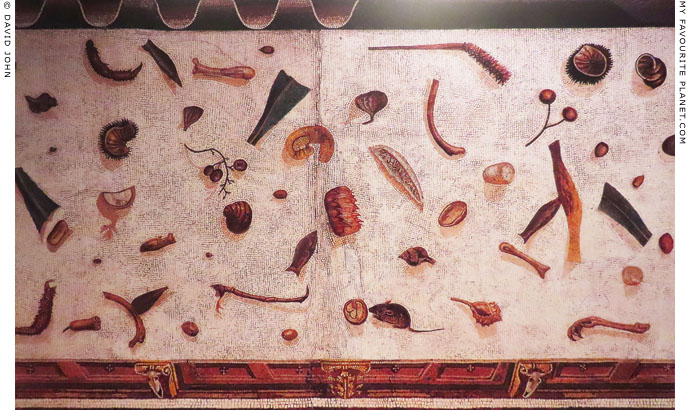
A detail of a marble mosaic of an "unswept room", depicting a mouse among the debris from a meal
lying on a white dining room floor, including nutshells, fruit stems and seeds, snail shells, a chicken
leg, bones and pieces of seafood. The objects are rendered in a realist "trompe l'oeil" (illusionistic)
manner. The mouse may have been added during restoration in the Renaissance.
2nd century AD. Found on the Aventine Hill, Rome. Signed by Heraklitos, ΗΕΡΑΚΛΙΤΟΣ ΕΡΓΑΣΑΤΟ
(Heraklitos ergasato), below a row of theatre masks along one edge of the floor. Thought to have
been inspired by the Hellenistic mosaic made by Sosos at Pergamon, 2nd - 1st century BC.
Museo Gregoriano Profano, Vatican Museums, Rome. Inv. No. 10132. |
| |
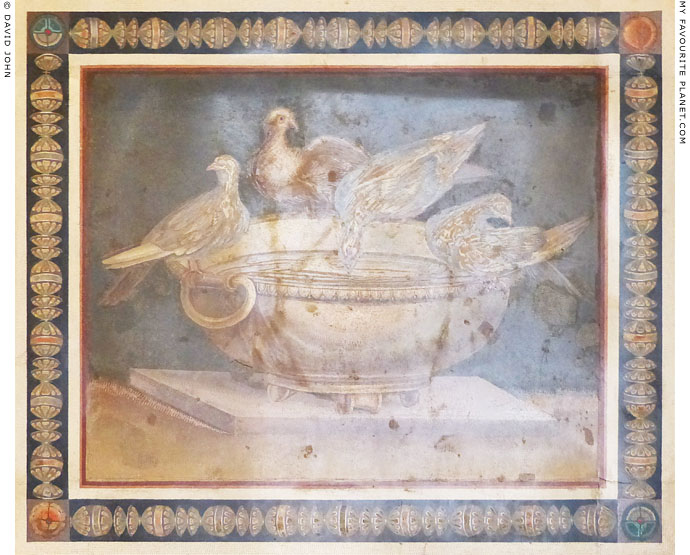
The "Mosaico delle Colombe" (Mosaic of the Doves), also known as the "Furietti mosaic",
the central emblema (panel) of a Roman period mosaic floor, with a depiction of four doves
perched on the rim of a three-legged golden bowl. One of the doves leans forward to drink.
A very fine opus vermiculatum work, made with very small tesserae. Thought to be a copy
of the mosaic made by Sosos at Pergamon, mentioned by Pliny the Elder. Found in 1737 during excavations by Giuseppe Alessandro Furietti (1685-1764), in the
centre of a floor in Hadrian's Villa, Tivoli, near Rome. Later sold by Furietti's heirs, along
with the "Furietti Centaurs" (marble statues), for 14,000 scudi to Pope Clement XIII,
who gave them to the Capitoline Museum in 1765. Height 85 cm, width 98 cm.
Sala delle Colombe (Hall of the Doves), Palazzo Nuovo,
Capitoline Museums, Rome. Inv. No. MC 402. |
| |
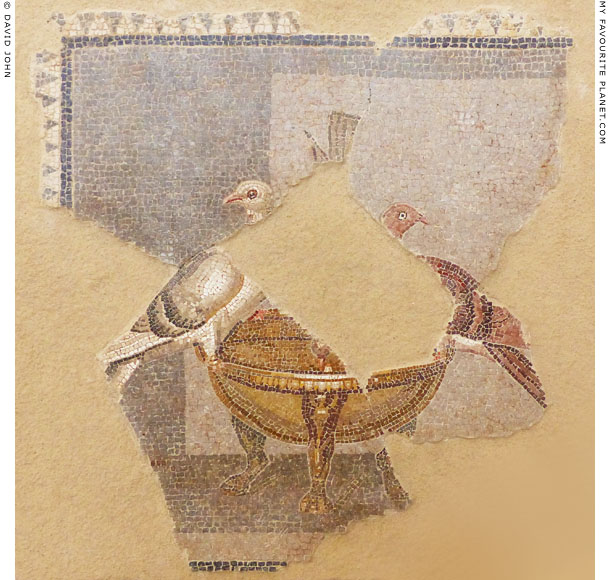
Fragments of a mosaic emblema (panel) with a depiction of two doves perched on the
rim of a three legged golden bowl. In the centre of the image part of the end of the tail
and the head of a third dove can be seen as it leans forward to drink from the bowl.
From Delos.
Delos Archaeological Museum. |
| |
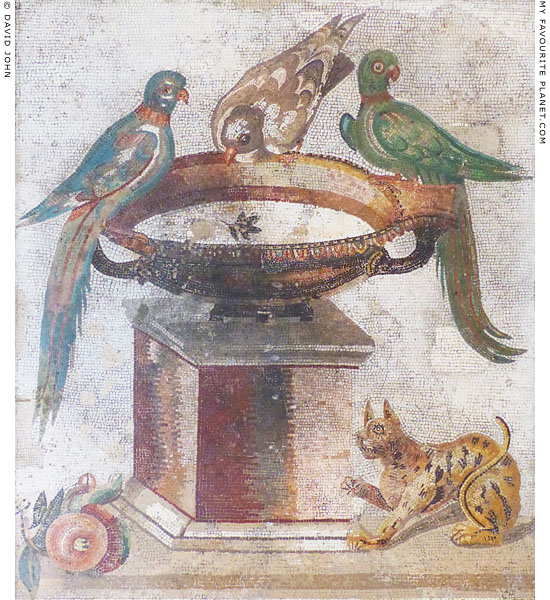
A mosaic emblema (panel) with a depiction of three birds perched on the rim
of a golden bowl on a plinth. The dove in the centre leans forward to drink.
A cat crouches at the foot of the plinth (right), and to the left are pomegranates.
From Santa Maria C. Vetere.
National Archaeological Museum, Naples. Inv. No. 9992. |
| |
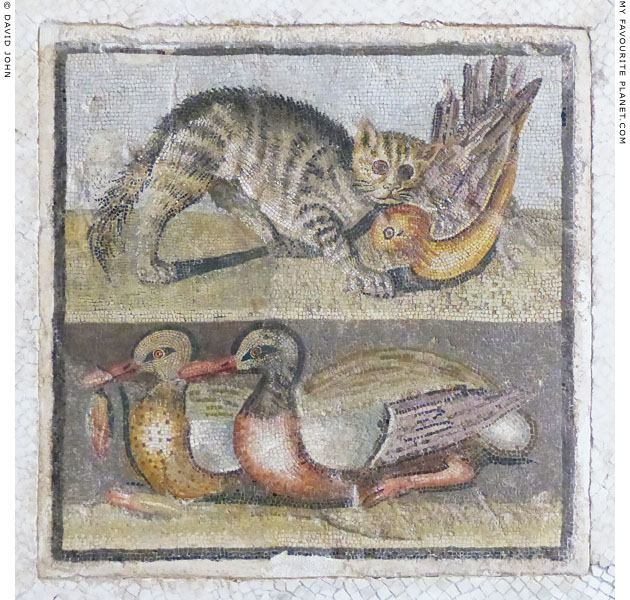
The central emblema (panel) of a Roman mosaic floor, surrounded by white tesserae.
The opus vermiculatum panel has images two registers. In the top register a cat
catches a bird. In the lower image are two ducks, one with a lotus flower in its beak.
1st quarter of the 1st century BC. Found in the triclinium
(dining room) of a Roman villa on the Via Ardeatina, Rome.
Palazzo Massimo alle Terme, National Museum of Rome. Inv. No. MC 124137.
A mosaic with the same two images was discovered in December 1830 in the House of the Faun
(Casa del Fauno, VI, 12, 2, 30), Pompeii. Dated around 100-80 BC, it is of higher quality and more
detailed. Below the ducks are four birds and various dead marine animals (sea food) depicted at
a smaller scale. 50cm x 50cm. National Archaeological Museum, Naples. Inv. No. 9993. |
| |
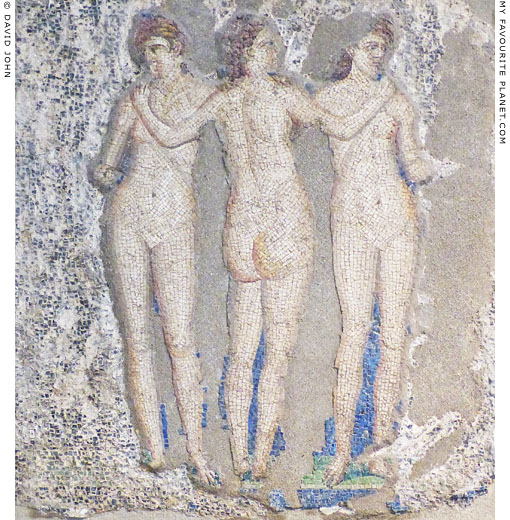
A mosaic emblema (panel) from Pompeii depicting the three Graces
(Greek, Χάριτες, Charites; Latin, Gratiae, Graces).
From the garden of the Casa di Apollo (VI, 7, 23), Pompeii.
National Archaeological Museum, Naples. Inv. No. 1004. |
| |
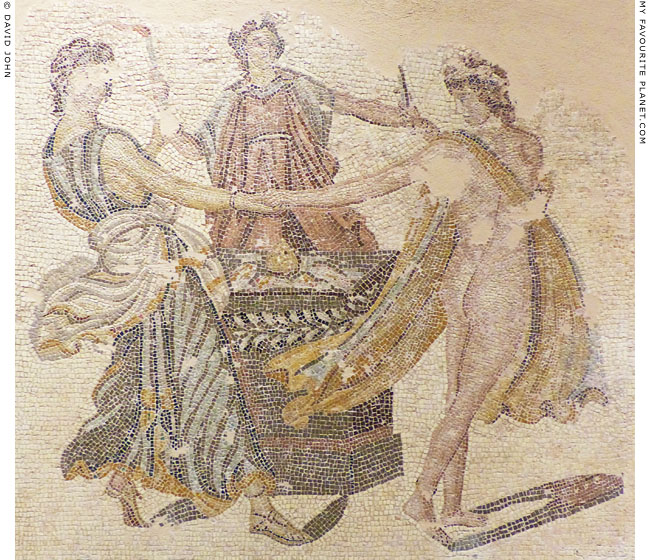
A mosaic emblema (panel) with a depiction of the three Graces
dancing around a garlanded altar, on top of which lie offerings.
From a Roman villa in Patras, northwestern
Peloponnese, Greece. 2nd - 3rd century AD.
Patras Archaeological Museum. |
| |
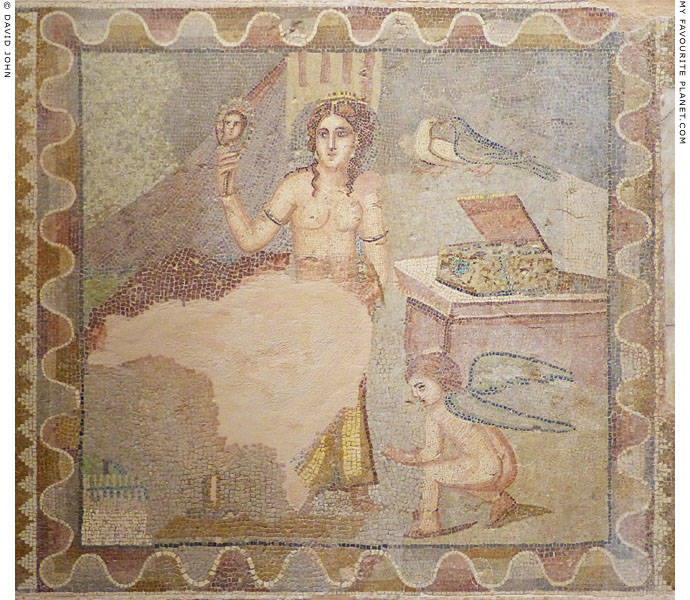
The central emblema (panel) of a floor mosaic depicting Aphdrodite holding
a mirror in her right hand. An infant winged Eros kneels before her.
From a Roman villa at Psila Alonia Square,
in the centre of Patras, Greece. 2nd century AD.
Patras Archaeological Museum.
|
Aphrodite stands in the middle of a mosaic floor, facing forwards, her head turned slightly to the viewer's left. She gazes at a hand mirror she has taken from a gaily decorated box which lies open on a table to the right. Although it appears that the artist has cleverly placed the mirror at an angle to show Aphdrodite's reflection, it is thought that this is the back of the mirror and that the face is that of Medusa. On a parapet above the table stand a pair of doves, symbolizing love and fidelity. Behind the goddess, a curtain attached to a column blows in the breeze. Her naked lower torso and legs were covered by a yellow garment during a reworking of the mosaic in the Christian period.
This is one of the large mosaics in the Patras museum that have been exhibited vertically against walls, so that their compositions and imagery can be appreciated by visitors. A good idea. Unfortunately, a few others are displayed horizontally on the floor, making them much more difficult to view (see, for example, a mosaic of Polyphemos in Homer part 3). |
|
|
| |
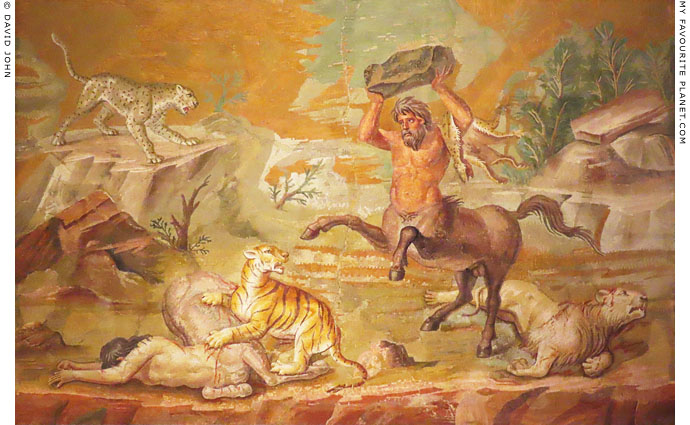
A part of a Roman period floor mosaic with a depiction of
a pair of Centaurs fighting a leopard, a tiger and a lion.
Made of natural stones of various colours, around 130 AD, perhaps after
a Greek mosaic or painting of the Hellenistic period. From the dining room
of the main palace of Hadrian's Villa complex, Tivoli, near Rome.
Altes Museum, Berlin. Inv. No. Mos. 1. Acquired in 1846.
The theme of Centaurs fighting large cats is not common in classical art, but appears, for
example, on a fragmentary front panel of a marble Roman period sarcophagus in Thessaloniki.
On the left one Centaur (facing right), raising a double-headed axe, fights a lion. On the right
another Centaur (facing left) fights a panther. The two cats, back-to back, facing out from the
centre, stand in front of a tree. Thessaloniki Archaeological Museum. Inv. No. 10234. |
| |
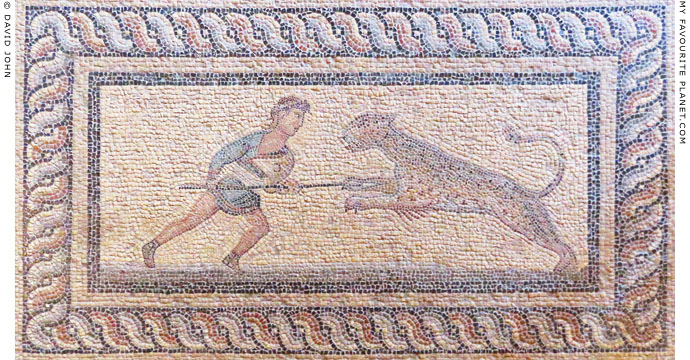
The centre of a floor mosaic from the Dodecanese island of Kos with a depiction of a hunter
lunging with a spear at a pouncing leopard. the scene is surrounded by a guilloche pattern.
Either side of the frame is a lateral compartment (not visible in photo) with an ivy tendril
in grey stones on a background of white stones.
Second half of the 3rd century AD. One of many mosaics discovered in the main town of
Kos by Italian archaeologists, following the devastating earthquake of 1933. Several were
taken to Rhodes to decorate the floors of the newly restored Palace of the Grand Master.
Palace of the Grand Master, Rhodes, Dodecanese, Greece. |
| |
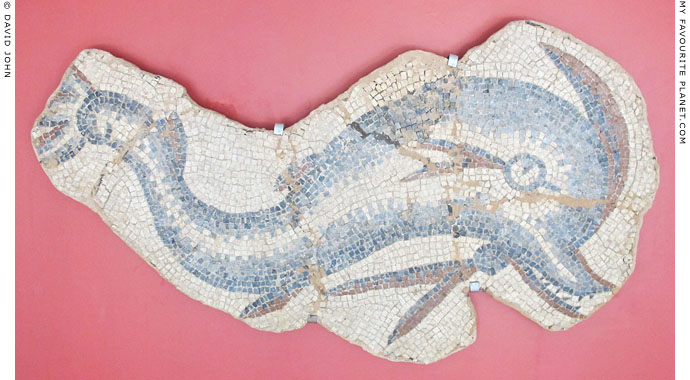
A fragment of a Byzantine mosaic from Pergamon
with a depiction of a dolphin. 5th - 6th century AD.
Izmir Museum of History and Art. |
| Photos and articles © David John, except where otherwise specified. |
 |
Visit the My Favourite Planet Group on Facebook.
Join the group, write a message or comment,
post photos and videos, start a discussion... |
|
|
| |
|
|
| |
| |
 |
| |
 |
| |
 |
| |
 |
| |
 |
| |
 |
| |
George Alvanos
rooms in
Kavala's historic Panagia District
Anthemiou 35,
Kavala, Greece
kavalarooms.gr
|
| |
Olive Garden Restaurant
Kastellorizo,
Greece
+30 22460 49 109
kastellorizo.de
|
| |
Papoutsis
Travel Agency
Kastellorizo,
Greece
+30 22460 49 286
greeklodgings.gr
|
| |
|